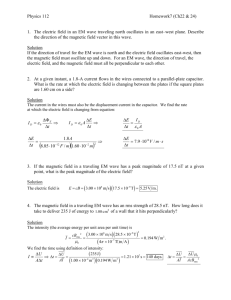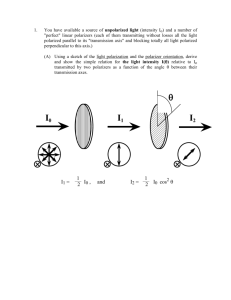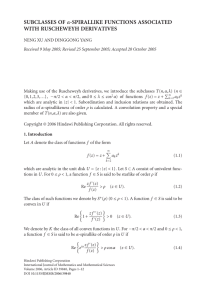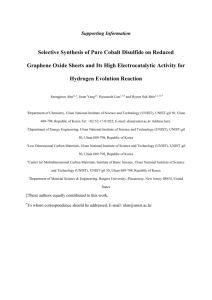Homework Set 10
advertisement
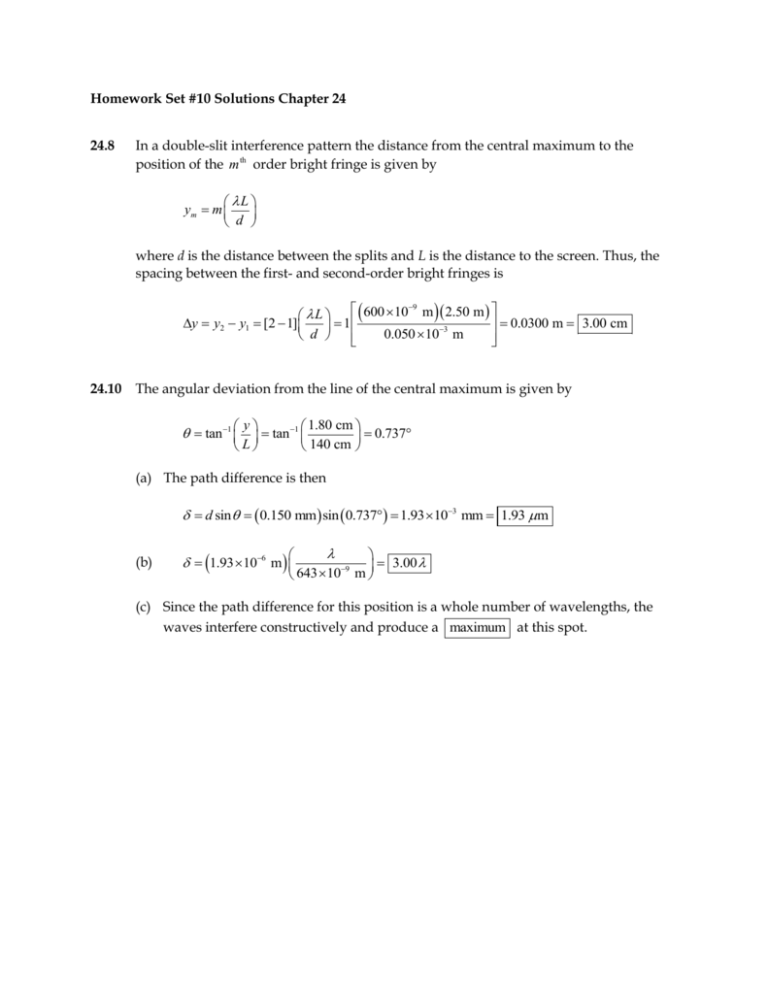
Homework Set #10 Solutions Chapter 24 24.8 In a double-slit interference pattern the distance from the central maximum to the position of the m th order bright fringe is given by L ym m d where d is the distance between the splits and L is the distance to the screen. Thus, the spacing between the first- and second-order bright fringes is 9 L 600 10 m 2.50 m y y2 y1 [2 1] 0.0300 m 3.00 cm 1 0.050 103 m d 24.10 The angular deviation from the line of the central maximum is given by y 1.80 cm tan 1 tan 1 0.737 L 140 cm (a) The path difference is then d sin 0.150 mm sin 0.737 1.93 103 mm 1.93 m (b) 3.00 9 643 10 m 1.93 106 m (c) Since the path difference for this position is a whole number of wavelengths, the waves interfere constructively and produce a maximum at this spot. 24.11 As shown in the figure at the right, the path difference in the waves reaching the telescope is d 2 d1 d 2 1 sin . If the first minimum 2 occurs when 25.0 , then 180 90.0 40.0 , and d2 1 sin 250 m 2 1 sin 40.0 350 m Thus, h d2 sin 25.0 148 m 24.14 With nglass nair and nliquid nglass , light reflecting from the air-glass boundary experiences a 180° phase shift, but light reflecting from the glass-liquid boundary experiences no shift. Thus, the condition for destructive interference in the two reflected waves is 2nglass t m where m 0, 1, 2, For minimum (non-zero) thickness, m 1 giving 24.22 t 2nglass 580 nm 193 nm 2 1.50 With a phase reversal due to reflection at each surface of the magnesium fluoride layer, there is zero net phase difference caused by reflections. The condition for destructive interference is then 1 1 2 t m n m , where m 0, 1, 2, 2 2 n film For minimum thickness, m 0 , and the thickness is t 2m 1 4 n film 550 10 1 9 4 1.38 m 9.96 10 8 m 99.6 nm 24.23 There is a phase reversal upon reflection at each surface of the film and hence zero net phase difference due to reflections. The requirement for constructive interference in the reflected light is then 2 t mn m n film , where m 1, 2, 3, With t 1.00 105 cm 100 nm , and n film 1.38 , the wavelengths intensified in the reflected light are 2 n film t m 2 1.38 100 nm , with m 1, 2, 3, m Thus, 276 nm, 138 nm, 92.0 nm and none of these wavelengths are in the visible spectrum 24.45 From Malus’s law, the intensity of the light transmitted by the first polarizer is I1 I i cos2 1 . The plane of polarization of this light is parallel to the axis of the first plate and is incident on the second plate. Malus’s law gives the intensity transmitted by the second plate as I 2 I1 cos2 2 1 I i cos2 1 cos2 2 1 . This light is polarized parallel to the axis of the second plate and is incident upon the third plate. A final application of Malus’s law gives the transmitted intensity as I f I 2 cos2 3 2 I i cos2 1 cos2 2 1 cos2 3 2 With 1 20.0, 2 40.0, and 3 60.0 , this result yields I f 10.0 units cos2 20.0 cos2 20.0 cos2 20.0 6.89 units 24.47 (a) If light has wavelength in vacuum, its wavelength in a medium of refractive index n is n n . Thus, the wavelengths of the two components in the specimen are n 1 and n1 546.1 nm 413.7 nm 1.320 n 2 n2 546.1 nm 409.7 nm 1.333 (b) The number of cycles of vibration each component completes while passing through the specimen are N1 t n 1 and 1.000 10-6 m 2.417 413.7 10-9 m N2 t n 2 1.000 10-6 m 2.441 409.7 10-9 m Thus, when they emerge, the two components are out of phase by N 2 N1 0.024 cycles . Since each cycle represents a phase angle of 360°, they emerge with a phase difference of = 0.024 cycles 360 cycle 8.6 24.52 Assuming the glass plates have refractive indices greater than that of both air and water, there will be a phase reversal at the reflection from the lower surface of the film but no reversal from reflection at the top of the film. Therefore, the condition for a dark fringe is 2 t mn m n film for m 0, 1, 2, If the highest order dark band observed is m 84 (a total of 85 dark bands counting the m 0 order at the edge of contact), the maximum thickness of the wedge is tmax mmax 84 42 2 n film 2 1.00 When the film consists of water, the highest order dark fringe appearing will be n 1.333 mmax 2 tmax film 2 42 112 Counting the zeroth order, a total of 113 dark fringes are now observed.


